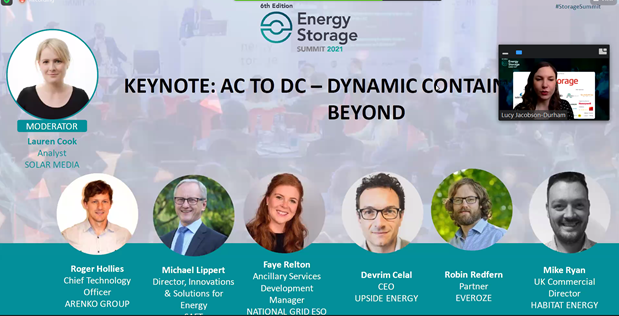
The benefits – and remaining challenges – of the UK’s new frequency response service Dynamic Containment (DC) were discussed at today’s Energy Storage Summit by a panel of experts and industry stakeholders.
The sub-second, post-fault response service was first soft-launched in October 2020 and is – as Devrim Celal, CEO of energy tech firm Upside Energy, described today – “truly the first digital solution that’s come out of National Grid”.
Enjoy 12 months of exclusive analysis
- Regular insight and analysis of the industry’s biggest developments
- In-depth interviews with the industry’s leading figures
- Annual digital subscription to the PV Tech Power journal
- Discounts on Solar Media’s portfolio of events, in-person and virtual
The service is largely lauded for its lucrative revenues, with Mike Ryan, UK commercial director at battery optimisation and energy trading firm Habitat Energy telling the audiences virtually gathered at the Summit that this is “clearly one of the things that’s attracting all asset owners” into the market, adding it “consistently outstrips anything else out there”.
Indeed, the average price in DC comes in around £17 (US$23.96) /MW/h- though this is not the only benefit of the service with “the other great opportunity” being the ability to stack with the Balancing Mechanism, Ryan added.
This ability was added in January 2021, allowing assets to charge using the BM and discharge into DC.
Whilst batteries are not the only technology allowed into the service, the fact DC is a post-fault service requiring assets to respond “very quickly and very accurately” – in the words of Roger Hollies, chief technology officer of Arenko Group, also speaking on today’s panel – means that batteries are well placed.
“Batteries inherently are very, very fast,” he explained, adding that while DC has “quite high standards, it is by no means difficult for a battery asset” and that Arenko is in fact having to slow down the assets it has entered into the service. He echoed Celal by praising the service as “the first that is really starting to expose the capability of digitally controlled assets”.
However, while batteries are well suited to the requirements of DC, the service is “extremely precise, requires data sampling rates that have never been tested before at 20hz and gives you a very narrow margin of error”, according to Celal, who continued to state that some older battery assets were “never designed for a service like DC” and as a result some may “need a bit of a physical upgrade”.
When it comes to the testing required for a battery to provide DC, Robin Redfern, partner at Everoze, said that there are two main challenges, the first of which being “the accuracy, the precision that’s required and that batteries can meet”, adding that the whole chain of measurement “needs to be well designed and engineered” with frequency measurement being “the tricky bit”.
“Frequency as well as know is varying all the time, so it takes time to measure accurately”, he said, continuing to say “the first message I would have is to think very carefully about frequency measurement devices”.
The second key point, Redfern said, is speed of response, which “is very achievable for batteries- it’s what they’re good at” but still requries “a bit of consideration from those designing and testing those projects”.
The Energy Storage Summit 2021, hosted by out publish Solar Media, will continue in its exciting new format on 24 February and again on 3-4 March. See the website for more details.






